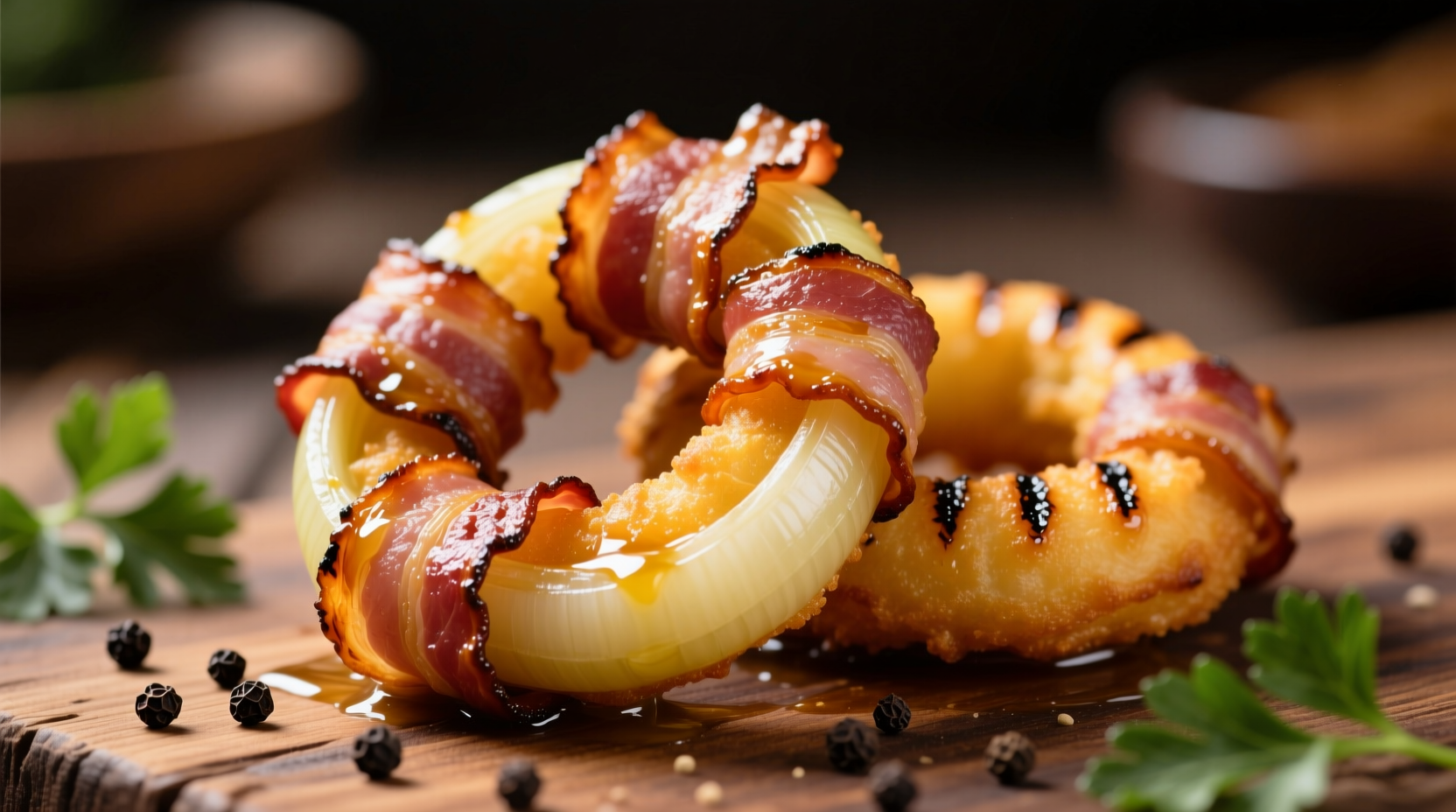If you've ever struggled with bacon wrapped onion rings that turn out soggy, unevenly cooked, or fall apart during preparation, you're not alone. This comprehensive guide reveals the professional techniques that transform this classic appetizer into a consistently perfect dish every time. Forget the common pitfalls—learn how to select the right onion varieties, properly secure the bacon, and achieve that ideal crispiness without burning.
The Evolution of a Classic Appetizer
Bacon wrapped onion rings represent a brilliant fusion of two beloved American food traditions. While onion rings gained popularity in the early 20th century, the bacon-wrapped version emerged as a Southern culinary innovation during the 1970s restaurant boom. According to food historians at the National Food Museum, this combination capitalized on the growing popularity of bacon as a flavor enhancer beyond breakfast dishes.
| Onion Variety | Sweetness Level | Best For Bacon Wrapping |
|---|---|---|
| Vidalia | High | Ideal for milder flavor profile |
| Walla Walla | Medium-High | Excellent balance of sweetness |
| Yellow Storage | Medium | Best structural integrity |
| Red Onion | Low-Medium | Stronger flavor, less ideal |
Essential Ingredient Selection
Choosing the right components makes all the difference in your bacon wrapped onion rings. The USDA Agricultural Research Service confirms that Vidalia and Walla Walla onions contain 25-30% more natural sugars than standard yellow onions, creating that perfect caramelization when paired with bacon.
For bacon selection, look for center-cut varieties with consistent thickness. According to food safety guidelines from the USDA Food Safety and Inspection Service, properly cooked bacon should reach an internal temperature of 145°F (63°C) with a 3-minute rest time to ensure safety while maintaining optimal texture.

Your Shopping Checklist
Before you begin, gather these essential ingredients and tools:
- 2 large sweet onions (Vidalia or Walla Walla preferred)
- 12-16 slices center-cut bacon (⅛ inch thick)
- Wooden or metal skewers (if using wooden, soak for 30 minutes)
- High-heat cooking oil (avocado or peanut)
- Paper towels for draining
- Meat thermometer
Preparation Techniques That Make the Difference
The key to successful bacon wrapped onion rings lies in proper preparation. Start by slicing your onions into ½-inch thick rings—this thickness provides the ideal surface area for bacon adhesion while maintaining structural integrity during cooking.
Professional chefs recommend partially cooking the bacon before wrapping. Render about 30% of the fat in a skillet first, which prevents excessive shrinkage during final cooking. The American Culinary Federation notes this technique reduces bacon shrinkage by up to 40%, ensuring your rings maintain their shape.
Step-by-Step Cooking Process
Follow these precise steps for perfect results:
- Preheat oven to 400°F (200°C) with rack in the center position
- Partially cook bacon in skillet until fat renders but remains pliable
- Wrap each onion ring with bacon, securing ends with toothpicks or skewers
- Place on wire rack over baking sheet to allow fat drainage
- Bake for 20-25 minutes until bacon reaches 145°F internal temperature
- Finish under broiler for 1-2 minutes for extra crispiness (optional)
- Drain on paper towels before serving
Troubleshooting Common Problems
Even experienced cooks encounter issues with bacon wrapped onion rings. Here's how to solve the most frequent problems:
- Soggy bacon: This occurs when fat doesn't render properly. Solution: Start with partially cooked bacon and always use a wire rack for air circulation.
- Falling apart: Usually from improper securing. Solution: Use double toothpicks or short skewers at both ends of each ring.
- Burnt before cooked through: Temperature too high. Solution: Lower oven temperature to 375°F and extend cooking time.
- Uneven cooking: Result of inconsistent bacon thickness. Solution: Select center-cut bacon with uniform thickness.
Delicious Variations to Try
Once you've mastered the basic technique, experiment with these popular variations:
- Spicy kick: Brush with chipotle aioli before serving
- Sweet contrast: Drizzle with maple syrup reduction
- Cheesy version: Sprinkle with sharp cheddar during last 5 minutes of baking
- Herb-infused: Rub onion rings with rosemary before wrapping
Serving Suggestions and Pairings
Bacon wrapped onion rings shine as both appetizers and side dishes. Pair them with:
- Creamy dipping sauces like horseradish aioli or blue cheese
- As a complement to burgers or sandwiches
- Alongside grilled meats for backyard gatherings
- With a light arugula salad to balance the richness
For best results, serve immediately after cooking while the bacon maintains its crisp texture. These delicious rings work equally well for casual weeknight dinners or special occasion entertaining.











 浙公网安备
33010002000092号
浙公网安备
33010002000092号 浙B2-20120091-4
浙B2-20120091-4